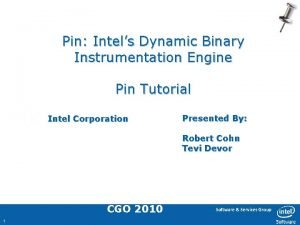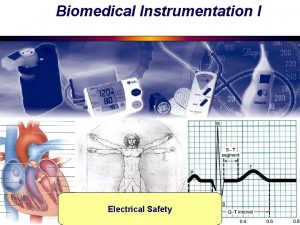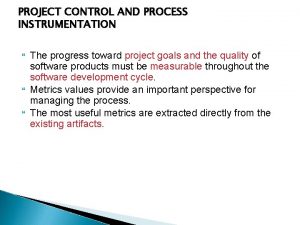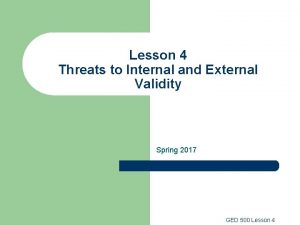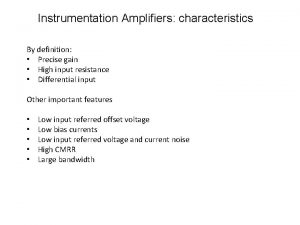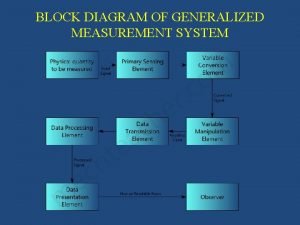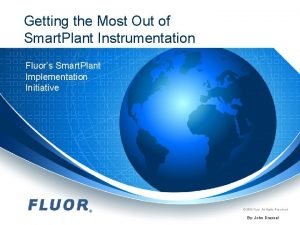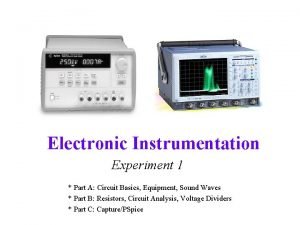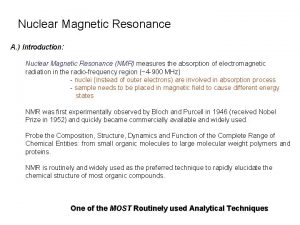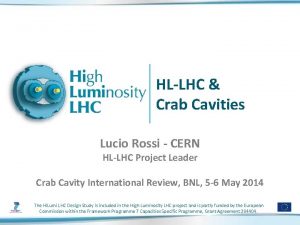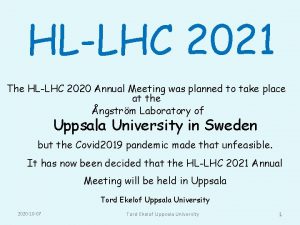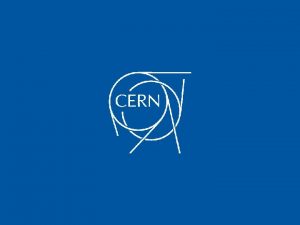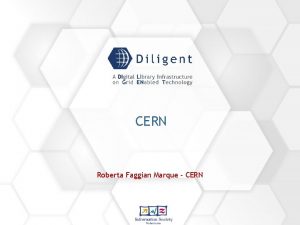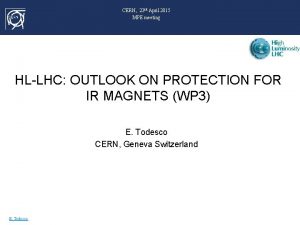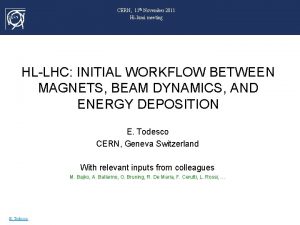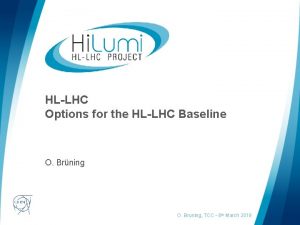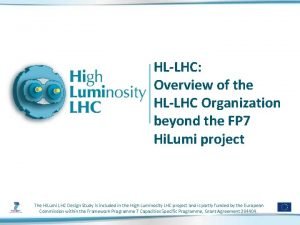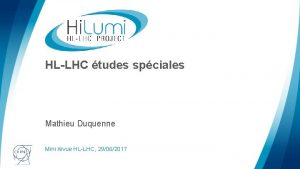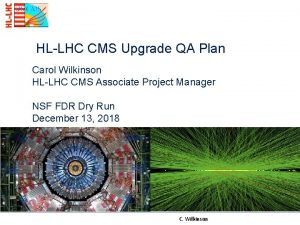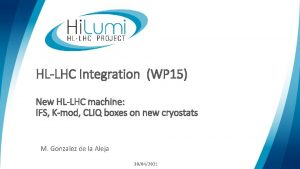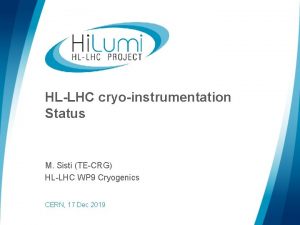HLLHC instrumentation meeting CERN TECRGCI HLLHC instrumentation meeting














- Slides: 14


HL-LHC instrumentation meeting CERN TE-CRG-CI HL-LHC instrumentation meeting 17. 12. 2019 - CRG-CI

Typical accelerator instrumentation measurement chain Topic: equipment exposed to non-negligible radiation levels (moderate and above) HL-LHC instrumentation meeting 17. 12. 2019 - CRG-CI

LHC case: instrumentation exposed to radiation Equipment deemed to be critical & non exchangeable was (fully ? ) tested for radiation: • Temperature sensors tested in cold conditions to the highest possible reasonable TID Equipment tested although exchangeable: • Electronic equipment installed in the tunnel • Pressure sensors (absolute > 1 bar range, differential & new ABB passive sensors) • Actuating part of the SIPART intelligent valve positioner Equipment considered rad-hard by design • LHe superconducting gauges (same material as magnets) • Electrical heaters (wire-wound type used, no single failure reported or known yet) • End-switches (only mechanical type) • Coriolis flowmeters (purely mechanical device) • LHC current lead valves (magnetic field provided by coil, purely geometrical) • Air actuated valves (purely mechanical device) HL-LHC instrumentation meeting 17. 12. 2019 - CRG-CI

Measurement of temperature Magnets temperature measurement is critical: • directly linked with the operational margin • reduced with increased error on the measurement • LHC target on uncertainty 0. 01 K Such a target was usual at the lab but never in large scale facilities. Development required: • Improvement of sensor anchoring: thermometer block with thermal anchoring • • Understanding the sources of drift/noise on the sensing element • Long term drift simulated with thermal cycles => cernox selected • Radiation effects in cold conditions • 5 x 1014 n/cm 2 (10 k. Gy); 1’ 000 hour of irradiation below 2. 0 K • Cernox, TVO and allen-bradleys + platinum selected Potential electromagnetic noise & cost reduction => keep signal cables as short as reasonable • Rad. Tol electronics required (dealt later) HL-LHC instrumentation meeting 17. 12. 2019 - CRG-CI

Measurement of temperature: detail on tests 100 thermal cycles - Cernox excels in particular with increasing temperature - All sensors with increasing resistance when lowering the temperature show similar behavior - Note complete thermal annealing for germanium sensor - Room temperature irradiation is meaningless for this tek. HL-LHC instrumentation meeting 17. 12. 2019 - CRG-CI

Measurement of temperature: Intrinsic accuracy for cernox The calibration station uses 1995 state of the art apparatus, anyway the accuracy is still excellent as for today. - The reference temperature is provided by RIRT sensors, reproducibility ± 0. 005 K between 1. 5 & 300 K - The reproducibility between two runs for the SAME cernox sensors exchanged in position is shown - The temperature spread increases with increasing temperature - The WFIP LHC electronics is less accurate than lab type source & volt meters HL-LHC instrumentation meeting 17. 12. 2019 - CRG-CI

Measurement of pressure All pressure sensors are accessible and therefore exchangeable. • Absolute LHC pressure sensors provided by Baumer (CH), resistive bridge Procurement OK but minimum order qty about 50 units • Differential LHC pressure sensors provided by Polaron Schaewiz (? ), resistive bridge Not available for purchase • Absolute LHC low pressure sensors provided by NICHE (FR), inductive bridge Unfortunately not available for purchase Mechanical/geometrical device: not qualified for radiation • ABB has delivered passive pressure cells for absolute & differential applications Radiation tests show some drift Still looking for other suppliers, in particular for differential & low pressure application • HL-LHC instrumentation meeting 17. 12. 2019 - CRG-CI

Measurement: level, cold flow, valve actuators Liquid He level measurement is a mature technology, however: • Accuracy is hardly better than 10 mm • European suppliers (i. e. Cryogenics Ltd – UK) provide relatively wide changes in specs • Present part uses a steel tube and shorts to case (GND) are observed in our samples • It can be capricious due to changes in pressure, lambda point, etc. Cold flow will be measured by commercial Coriolis devices made by Micro Motion • Requires very long connecting signals cable because electronics is not qualified for radiation Valve actuators have been qualified for radiation use up to about 100 k. Gy • Most sensitive part are the micro valve piezo-actuators • If radiation is too high the piezo actuators can be moved away from valve stem • LHC failures due to potentiometer noise (wear? , corrosion? ) or leaks Electrical heaters • For cryogenic use all the electrical resistances are wire-wound type or PCB type (FR-4 or polyimide) • Beware of film deposited teks as they have already cracked when cooled to 4. 2 K Valves • DFB current leads never qualified for radiation, rad hard by design (mechanical + magnetic) • Pressure actuated valves: diaphragm may be degraded by radiation? HL-LHC instrumentation meeting 17. 12. 2019 - CRG-CI

Radiation Tolerant Electronics The LHC radiation tolerant electronics is compatible with most of the types of channels present in the LHC machine. Radiation accumulative effects are similar to thermal effects that cause drift in analog values • Most of the measurements rely on comparison bridges to compensate for drift The reference element (resistor for example) shall be insensitive to radiation The electronic cards installed in the LHC are not showing signs for end of life. Most difficult task is dealing with obsolescence • Anti-fuse FPGAs price increased significantly, it may indicate will to end production • WFIP CC-131 present card version is very sensitive to radiation due to change of ICs HL-LHC instrumentation meeting 17. 12. 2019 - CRG-CI

Radiation Tolerant Electronics: Sensor measurement The WFIP provides inputs for different types of measuring instruments • Temperature sensors based in variable resistance • Versions with grounded and 2 k. V galvanic insulated signals. • Accuracy depends on digitization/range/value: Typical values: < 0. 25% on resistance. • New card provided better resolution (x 5) than original LHC design and accuracy <0. 1%. • Pressure: capable of measuring both resistive and inductive bridges • Superconducting level gauge: • Measuring conditions that cope with the “known” gauge manufacturers • New version copes better with common mode voltage. Under production will be deployed during next year. • Range: Up to 2 k. Ohm, 40 to 500 m. A (Resistance x current < 65 V/96 V for crate/standalone). • Standalone version to handle faults to ground. • Standalone to support modes of operation: E. g. different excitation based on magnetic field. HL-LHC instrumentation meeting 17. 12. 2019 - CRG-CI

Radiation Tolerant Electronics: Programmable Supplies The WFIP provides outputs for different types of electrical loads • DC (non-isolated linear) voltage supply with a 0 -60 Vdc & 0 -0. 5/2 A compliance • Compliance depends on applied load due to the dissipation of the linear regulator. • Typical values: Max 25 W@100 R + 100 W@25 R without ventilation. 100 W+100 W @ 25 R (or less) with ventilation. • AC (isolated PWM) voltage supply with a 0 -230 VAC & 0 -4 A compliance. • Card can operate with up to ~400 VAC / 10+ A with some modifications. • • DC (non-isolated PWM). Modifications or a revision of the card could make it capable operating in DC (PWM) mode significantly with compliance similar to the one of the AC mode. Configuration might increase noise, feasibility by design, not tested yet in the lab. Accuracy: • Reception tests put limits on power at 2% for DC (linear) and 8% on AC (PWM). HL-LHC instrumentation meeting 17. 12. 2019 - CRG-CI

Final Comments Are there alternatives to LHC selected temperature sensors? • For platinum yes, but probably cost would be higher without any gain in accuracy • For cernox there is no alternative, it is a relatively “young” technology first reported by end 1987 (developed in Japanese labs and commercial part since 1993, • In any case the development of a sensor is difficult and may result in early obsolescence • Example: HERA (DESY) only user of carbon film temperature sensor Never validated by metrologists (only cryo engineers) => not produced anymore HL-LHC instrumentation meeting 17. 12. 2019 - CRG-CI

 What is meeting and types of meeting
What is meeting and types of meeting Types of meeting
Types of meeting Today meeting or today's meeting
Today meeting or today's meeting Proposal kickoff meeting agenda
Proposal kickoff meeting agenda Instrumentation of centrifugation
Instrumentation of centrifugation Pin tool tutorial
Pin tool tutorial Electrical safety in biomedical instrumentation
Electrical safety in biomedical instrumentation The seven core metrics
The seven core metrics External validity example
External validity example Characteristics of instrumentation amplifier
Characteristics of instrumentation amplifier Chapter three research methodology
Chapter three research methodology Generalized measurement system
Generalized measurement system Smart plant instrumentation
Smart plant instrumentation Rpi electronic instrumentation
Rpi electronic instrumentation Nmr spectroscopy diagram
Nmr spectroscopy diagram





